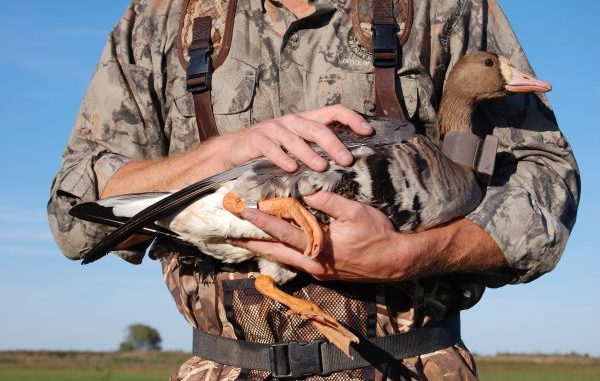
White-fronted goose number down sharply over past 20 years
The number of specklebelly geese wintering in Louisiana has fallen sharply — from 80 percent of the mid-contintenal population 20 years ago to an average of only 32 percent spending the winter within the Bayou State — and the state biologist are working to understand why through a new study of goose distribution.
The decline in specklebellies (aka white-fronted geese) wintering in Louisiana comes as the overall mid-contintental population increase, the Louisiana Department of Wildlife and Fisheries said.
In the face of these changes, the Louisiana Wildlife and Fisheries Commission chose in August to implement less than the federally allowed season length.
Commissioners also charged LDWF with investigating sources of the trend to inform future management and hunting regulation decisions.
The study involves capturing, banding, and fitting specklebellies with transmitters that will allow tracking of the birds’ movements and habitat use, the LDWF said.
Suspected causes for the Louisiana decline include significant changes in agricultural practices, lasting hurricane effects, and increased urbanization and industrialization in historic goose habitats, the agency said.
Hunting pressure also has increased, with twice as many active waterfowl hunters today compared to that in 2005, the agency said.
With funding donated by private individuals and organizations, 11 transmitters were acquired to place on white-fronted geese, the agency reported. LDWF has committed to deploying additional transmitters next fall as well.
Paul Link, LDWF’s North American Waterfowl Management Plan coordinator, said wintering specklebellies have proved difficult to catch in meaningful numbers.
“Having access to high-quality habitats for trapping efforts was critical to this research,” Link said. “We are very thankful for the access granted by private landowners and staff at the Southwest Louisiana National Wildlife Refuge Complex.”
Link and his student workers caught 79 white-fronts during October and November. All were leg-banded, and 11 adults were fitted with the transmitter units.
Up to 48 GPS locations per day are being collected on each bird fitted with a transmitter.
“These 11 white-fronts are the first wild birds to carry this technology, which is exciting,” Link said.
Transmitters are expected to last three to four years, which will help identify habitats used, local and long-range movements, fidelity among wintering and breeding areas, as well as spring and fall migratory routes and stopovers, the LDWF said.
Six white-fronts were fitted with transmitters on Oct. 18 in Southwest Louisiana and were still there on Nov. 7, which was opening day of the coastal zone waterfowl season.
Within three days, five of those six birds had left the coastal zone during a time of stable weather. It is too early to say whether the movement was prompted simply by the onset of hunting season, food depletion, improving habitat conditions elsewhere or a combination of these and other factors.
Another five white-fronts were fitted with transmitters during the first split of the waterfowl season. As of today, six of the fitted geese are in Arkansas, four remain in Louisiana and one is in Texas, the LDWF said.
“It would be great to have more transmitters to deploy this winter to get more data on local habitat use and see if white-fronts continue to move out of Southwest Louisiana,” Link said. “They are moving around much more than we suspected, and are successfully avoiding harvest and predation.”
Any hunter shooting one of the geese with a transmitter is asked to contact Link at 225-765-2358 or plink@wlf.la.gov and turn in the unit so it can be redeployed on another goose.
LDWF will exchange a replica non-working transmitter as a keepsake for the hunter.
Anyone interested in making a tax-deductible donation to purchase transmitters can contact Link.


